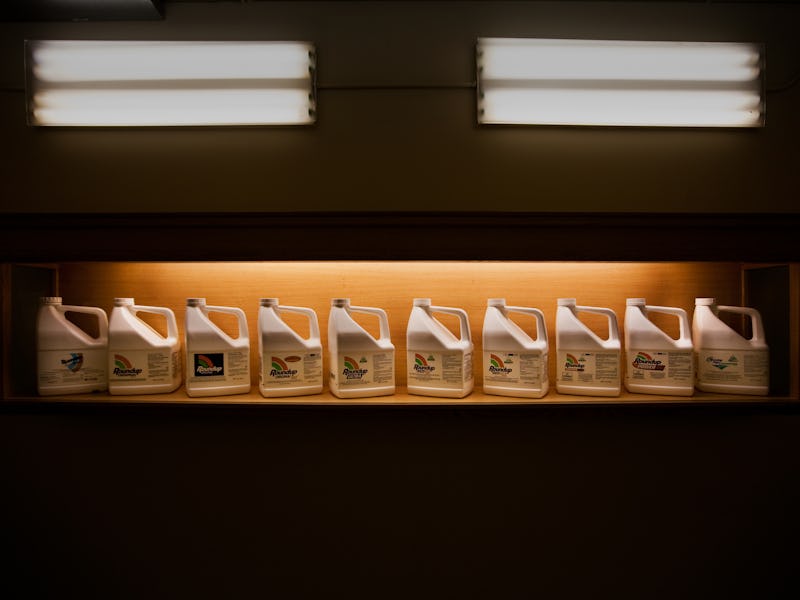Why Monsanto's Glyphosate Is So Dangerous to Humans
"Farmers have sprayed billions of pounds of a chemical now considered a probable human carcinogen."

The herbicide glyphosate that was originally only known as “Roundup” but now goes by, but is not limited to, “Roundup WeatherMax” and “Roundup UltraMax,” has been declared the most heavily applied weed-killer in the history of weed-killers.
The key ingredient of Monsanto’s signature product, 18.9 billion pounds of glyphosate have been used globally since the product was first sold commercially in 1974. In a study released Tuesday, American agricultural economist Chuck Benbrook notes that this global upsurge has coincided with increasing evidence that glyphosate may be detrimental to human health.
“This report makes it clear that the use of glyphosate combined with the dominance of genetically engineered crops has produced an looming public health threat both in the U.S. and around the world,” said Mary Ellen Kustin a senior policy analyst at the Environmental Working Group in a press release.
“Farmers have sprayed billions of pounds of a chemical now considered a probable human carcinogen over the past decade,” Kustin said. “Spraying has increased to multiple times a year recently on the majority of U.S. cropland. The sheer volume of use of this toxic weed-killer is a clear indication that this chemical dependency is a case of farming gone wrong.”
Roundup Ultra at Monsanto's St. Louis, Missouri headquarters.
Glyphosate was discovered in 1950 by Swiss chemist Dr. Henri Martin, who quickly learned it was not going to be helpful for his pharmaceutical company. Monsanto chemist Dr. John Franz realized that glyphosate would work as a herbicide in 1970, and the glyphosate-based Roundup premiered in 1974. But because the OG Roundup killed both weeds and crops (Whoops!), the product didn’t boom in the market until 1996, when Monsanto premiered “Roundup Ready” genetically engineered, herbicide-tolerant soybeans, maize, and cotton varieties. (Problem solved!) Those crops could handle glyphosate once the crops had already began to grow.
Due to herbicide-tolerant technology, the use of glyphosate by U.S. farmers experienced a 20-fold increase from 1995 to 2014, its use rising from 12.5 million pounds to 250 million pounds. As the planting of genetically engineered corn and soybeans became increasingly common so did the use of glyphosate — 74 percent of all glyphosate crop-use has only happened in the last 10 years. This data is based on the sum of three sources: National Agricultural Statistics Service data, pesticide use data sets from the U.S. Geological Survey, and periodic reports from the Environmental Protection Agency.
The global agricultural use of glyphosate has increased as well. The total volume applied by farmers outside of the United States rose from 113 million pounds in 1995 to 1.65 billion pounds in 2014 — an almost 15-fold jump.
But, as the use of glyphosate rose, so has the tolerance of weeds to the chemical agent. More than 20 weed species have become resistant to Roundup’s key ingredient in recent years, which has led farmers to increase their use of the product. In his paper, Benbrook writes that data is severely lacking when it comes to the rates of application of the pesticide. But he does offer this:
“Note the 2,000-fold increase in the glyphosate tolerance on dry alfalfa hay and silage from 1993 to 2014, an increase made necessary by the approval and planting of GE-HT alfalfa. In response to the large increase in expected residues from such uses, some European countries now prohibit harvest-aid applications on food crops.”
Monsanto's chief technology officer, Robert Fraley.
Not comforting in the light of glyphosate increase: It has the potential to be really bad for you. While EPA toxicology studies state that glyphosate has a “relatively low acute and chronic mammalian toxicity,” last year, a team of 17 scientists from the International Agency for Research on Cancer voted unanimously to raise the World Health Organization cancer profile of glyphosate.
The WHO now classifies glyphosate as “probably carcinogenic to humans” — a decision contested by agrochemical companies, including (of course) Monsanto who say that the EPA data directly goes against this finding. The EPA data that was in part, um, paid for by Monsanto.
“The IRAC is an independent agency whose sole mission is human health,” points out the Center for Food Safety, an independent nonprofit. “While the EPA is charged with protecting human health as well, it is also subject to considerable pressure from pesticide companies whose products it regulates.”
California is currently in the process of listing glyphosate as a chemical identified to cause cancer. Meanwhile, Benbrook references the work of other scientists who believe that glyphosate can bind to metals in mineral-heavy drinking water, meaning that it could fuck up your kidneys.
“The dramatic and rapid growth in overall use of glyphosate will likely contribute to a host of adverse environmental and public health consequences,” says Benbrook. “My hope is that this paper will stimulate more research on glyphosate use, and human and environmental exposure patterns, to increase the chance that scientists will quickly detect any problems that might be triggered, or made worse by glyphosate exposure.”